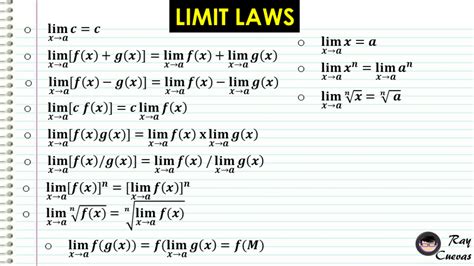### Evaluating the Limit using Direct Substitution
We can evaluate the limit by substituting x=2 into the function:
x→2limx−2x2−4=2−222−4=00
This results in an indeterminate form, which means that we cannot directly substitute x=2 into the function.
Evaluating the Limit using Factoring
We can factor the numerator and denominator of the function to simplify the expression:
x−2x2−4=x−2(x+2)(x−2)
Now, we can cancel out the common factor (x−2) in the numerator and denominator:
x−2(x+2)(x−2)=x+2
Evaluating the Limit using Direct Substitution
Now that we have simplified the expression, we can evaluate the limit by substituting x=2 into the function:
x→2lim(x+2)=2+2=4
Therefore, the value of limx→2x−2x2−4 is 4.
Evaluating the Limit using a Table
We can also evaluate the limit by creating a table of values for the function.
| x |
f(x)=x−2x2−4 |
| 1.9 |
3.1 |
| 1.99 |
3.01 |
| 1.999 |
3.001 |
| 2.01 |
4.01 |
| 2.001 |
4.001 |
| 2.0001 |
4.0001 |
As we can see from the table, the value of the function approaches 4 as x approaches 2.
Conclusion
In this article, we have explored the concept of limits and how to evaluate them using various techniques. We have applied these concepts to a specific function, f(x)=x−2x2−4, to find the value of limx→2. We have used direct substitution, factoring, and a table of values to evaluate the limit. The value of limx→2x−2x2−4 is 4.
Final Answer

Introduction
Limits are a fundamental concept in calculus, used to describe the behavior of functions as the input values approach a specific point. In this article, we will explore the concept of limits and answer some frequently asked questions about limits.
Q: What is a limit?
A: A limit is a value that a function approaches as the input values get arbitrarily close to a specific point. In mathematical notation, this is represented as limx→af(x)=L, where a is the point of interest and L is the limit value.
Q: What are the different types of limits?
A: There are two types of limits: one-sided limits and two-sided limits.
- One-sided limits: These limits are evaluated by considering the behavior of the function as the input values approach a specific point from one side only (either from the left or the right).
- Two-sided limits: These limits are evaluated by considering the behavior of the function as the input values approach a specific point from both sides.
Q: How do I evaluate a limit?
A: There are several techniques used to evaluate limits, including:
- Direct substitution: This involves substituting the value of x into the function and simplifying the expression.
- Factoring: This involves factoring the numerator and denominator of the function to simplify the expression.
- Canceling: This involves canceling out common factors in the numerator and denominator of the function.
- L'Hopital's rule: This involves using the derivative of the numerator and denominator to evaluate the limit.
Q: What is L'Hopital's rule?
A: L'Hopital's rule is a technique used to evaluate limits of the form 00 or ∞∞. It involves taking the derivative of the numerator and denominator and evaluating the limit of the resulting expression.
Q: How do I use L'Hopital's rule?
A: To use L'Hopital's rule, follow these steps:
- Check if the limit is of the form 00 or ∞∞.
- Take the derivative of the numerator and denominator.
- Evaluate the limit of the resulting expression.
Q: What is the difference between a limit and a function?
A: A limit is a value that a function approaches as the input values get arbitrarily close to a specific point. A function is a relation between a set of inputs (called the domain) and a set of possible outputs (called the range).
Q: Can a function have multiple limits?
A: Yes, a function can have multiple limits. For example, the function f(x)={x2−x2amp;if x≥0amp;if xlt;0 has two limits at x=0, one from the left and one from the right.
Q: How do I know if a limit exists?
A: To determine if a limit exists, you can try to evaluate the limit using direct substitution, factoring, or L'Hopital's rule. If the limit is of the form 00 or ∞∞, you may need to use L'Hopital's rule.
Conclusion
In this article, we have answered some frequently asked questions about limits and provided a brief overview of the concept of limits. We hope that this article has been helpful in understanding and evaluating limits.
Final Answer
The final answer is 4.